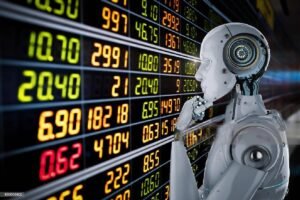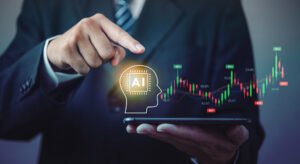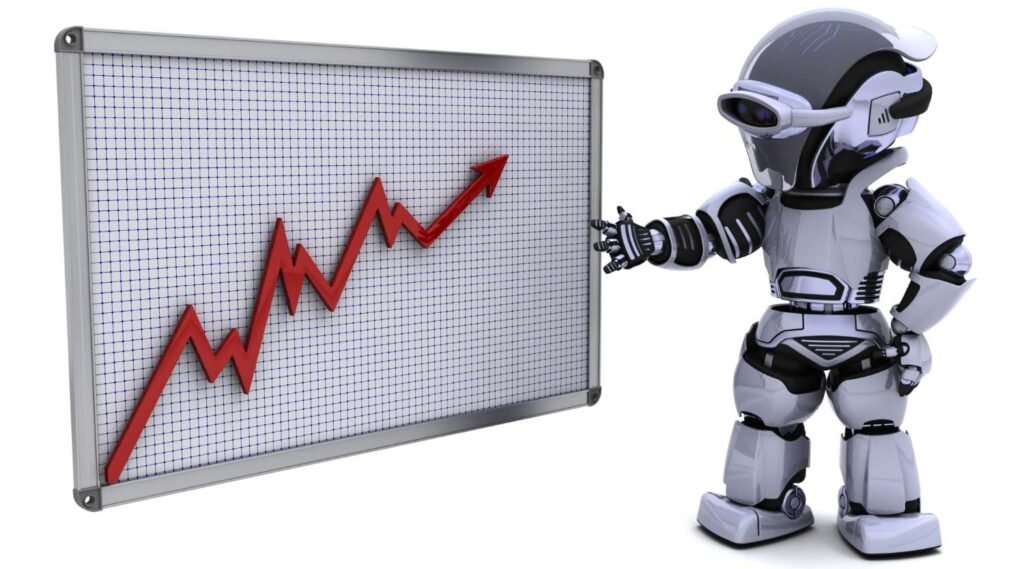Artificial intelligence is becoming more crucial in stock trading by the day. AI algorithms can process a lot of financial data, detect patterns we’d otherwise miss, and make super-fast trading choices to stay ahead.
With machine learning powering them, AI trading systems can operate 24/7. They can complete trades way faster than any human. However, along with the upsides, deploying AI has downsides if not done carefully.
To tap into AI’s potential, you need an approach which blends its strengths with human guidance on risks. But if it is used irresponsibly, AI can spin out of control. But combined with oversight and risk management, its accuracy and speed gives trading a valuable edge.
In this blog post we will explore different strategies of how to use AI to trade stocks.
What is AI in the Context of Stock Trading?
Artificial intelligence (AI) is transforming stock trading in major ways. In this context, AI refers to using advanced algorithms and computer systems to analyze massive amounts of financial data. The main goal is to spot patterns and make trading choices without much human input.
AI is being applied to stock trading to:
- Analyze Data: AI algorithms can process huge amounts of historical and current market data to identify trends, patterns, and potential trading opportunities.
- Automate Trading: AI systems can execute trades automatically based on predefined strategies and rules. This allows faster and more efficient trading.
- Manage Risk: AI can spot anomalies and possible risks by comparing present trades to past trading behaviors. This reduces mistakes and poor trading decisions.
Some examples of AI-powered platforms:
- Quantitative trading systems that utilize AI to parse price and volume data to find optimum trading strategies.
- Algorithmic platforms that make trades based on historical data and preset guidelines.
- High-frequency trading systems where AI makes quick automated decisions.
By tapping AI’s potential, traders can gain valuable insights, make informed calls, and potentially see higher returns while controlling risk. As technology advances, AI is poised to shape the future of trading more and more. This includes how to best use AI to trade stocks.
Benefits of Using AI for Stock Trading

AI could totally transform stock trading in some really positive ways:
- Faster data analysis: AI algorithms can digest tons of financial data at warp speed – way faster than any human. This lets traders quickly spot patterns, trends, and potential opportunities.
- Detecting overlooked patterns: AI’s awesome pattern recognition skills can uncover complex connections and anomalies that people might miss. This leads to smarter, more informed trading choices.
- 24/7 availability: AI trading systems run nonstop, all day, all week. So traders can jump on chances regardless of time zone differences or trading hours.
- Emotion-free decisions: AIs make moves based on facts, not feelings. This removes bias, panic, greed and other undesired human dynamics from the equation.
- Bigger returns, controlled risk: By leveraging AI to digest info and act quickly, traders can enjoy bigger profits with lower risk. AI can optimize portfolios, enable safety nets, and adapt to shifting conditions.
With responsible human oversight, AI could make stock trading faster, sharper and more profitable. As the tech advances, learning AI trading tactics would be a must for investors seeking an edge.
Risks and Challenges of AI Stock Trading

While AI trading offers some great potential benefits, some major risks and pitfalls come with the territory. Traders should be aware of:
- Relying too much on history: AI systems heavily study old market data to forecast moves. But past performance doesn’t guarantee future outcomes, especially when things shift quickly. So AIs can struggle to adapt when the market shifts suddenly.
- The black box issue: Many AI trading tools are not clear about how they make decisions. This lack of transparency can stir up uncertainty and mistrust, particularly when the AI makes odd or counterintuitive trades.
- No human intuition and judgment: AIs excel in data analysis and pattern finding. But they lack the gut instincts and big-picture perspective that seasoned traders have. So AIs might miss critical qualitative factors or unique situations requiring human judgment.
- Potential errors and inaccuracies: Despite their sophistication, AIs still make mistakes. Glitches can happen, especially amid unusual market conditions. Faulty data, programming bugs, or model flaws can lead to weird or inaccurate predictions and costly trades.
- Cybersecurity risks: AI trading systems are vulnerable to hacks, data breaches, and tech malfunctions. Attacks or outages could sink investments and cause market disruption.
- Regulatory changes and ethical concerns: Applying AIs to trading raises regulatory questions and moral concerns. Issues around bias, manipulation, and exacerbating financial inequality need addressing through sound regulations and ethics.
To stay safe, traders should use AIs carefully with human supervision. It’s very important to know the tech’s limits, ensure robust risk control, and watch for policy shifts.
How to use Ai to trade stocks
Implementing AI into your trading takes planning and care. Here are some key tips:
- Clearly define your goals for investing and how much risk you can bear. This helps ensure the AI you pick fits your overall trading philosophy.
- Research reliable AI trading platforms that have good reputations and reviews from real users. Look for tools offering features that best meet your needs.
- Make sure the AI models get trained on accurate, relevant, and current market data. Quality data is crucial for the AI to make smart trading decisions.
- When first using AI, invest small amounts to test how well the models perform. As you gain confidence in positive outcomes, gradually increase investment.
- Regularly monitor the AI models, and adjust strategies as required. Markets shift quickly, so it’s essential to adapt the AI accordingly.
- Have human oversight on decisions – use AI to complement your own analysis, not as a complete substitute.
- Stay updated on market trends, economic signals, and new regulations that may impact the AI. And change your strategies as needed.
Carefully refining your process allows AI to enhance trading performance. But remember – AI has limits and risks too. As you explore AI trading tools, use them responsibly with risk management.
Best practices for using AI responsibly and effectively

Tapping into AI’s potential while managing risks comes down to smart implementation:
- See AI’s limits: AI can analyze huge amounts of data and spot patterns. But it’s not always accurate. Models may run into problems with unseen events or quickly shifting markets.
- Use AI to complement human judgement: Combine AI insights with fundamental analysis, market knowledge, and your gut instinct. AI should enhance human decisions, not replace them.
- Diversify trading strategies: Don’t rely on AI alone. Spread investments across different assets, sectors, geographies to lower risk. Mix AI with other approaches for a more resilient strategy.
- Establish strong risk management systems: With AI trading, strict risk management is a must. Set clear guidelines for position sizing, stop-losses, profit-taking. Monitor AI trades and adjust risk parameters when needed.
- Keep testing and validating your AI models: Regularly test your model against historical data and see how your AI models would have done with old data. This checks their performance and spots any weak points. Also validate the AI’s predictions using fresh outside data to confirm the model works more broadly.trading systems
- Ensure your AI decisions are clear and understandable: Aim for AI models that give clear visibility into how they make trading choices. Understanding the why behind AI prediction builds trust and allows better human oversight.
- Follow relevant regulations and ethics around AI: Stay on top of the evolving regulatory landscape surrounding AI in finance. When you implement AI trading strategies, adhere to core principles like fairness, accountability, data privacy.
Remember that responsible AI use is an ongoing journey needing continuous refinement as markets shift. The main points to remember are monitoring, adapting and trading ethically.
Future of AI in stock trading

The role of AI in stock trading looks bright, with some exciting new technology trends that could shape the stock industry:
- Advanced AI and machine learning algorithms may enable trading strategies that are more flexible and adaptable.
- AI should keep getting better at real-time analysis of markets, measuring risk, and optimizing portfolios.
- We’ll likely see more automated trading systems that can manage trades without humans involved, fully powered by AI.
- AI is destined to play a crucial part in developing data-driven, quantitative trading strategies and investment strategies.
As AI tech progresses, it’s bound to have a profound impact on stock trading. But to implement AI responsibly and effectively, ongoing research and development will be key. That will help balance AI’s potential with the need for human oversight and ethical considerations. Learning how to apply AI in trading will become more and more important for investors wanting to stay competitive in the evolving market.
Conclusion
The bottom line is AI could totally transform stock trading by making it more efficient, accurate, and risk-aware. However, it’s crucial to realize AI has upsides and downsides:
- AI can surface useful insights and automate trading tasks, but relying too much on AI can be risky, especially when markets are volatile.
- Using AI wisely in trading matters – combine its power with human judgment and oversight.
- More research on AI trading is still needed to address issues like bias, transparency, and following regulations.
So if you’re an investor searching how to use AI to trade stocks, see AI as a way to boost, not replace, human expertise. By keeping up with developments in AI trading, having robust risk management plans, and keeping a balanced approach, you can benefit from AI while managing potential issues.


